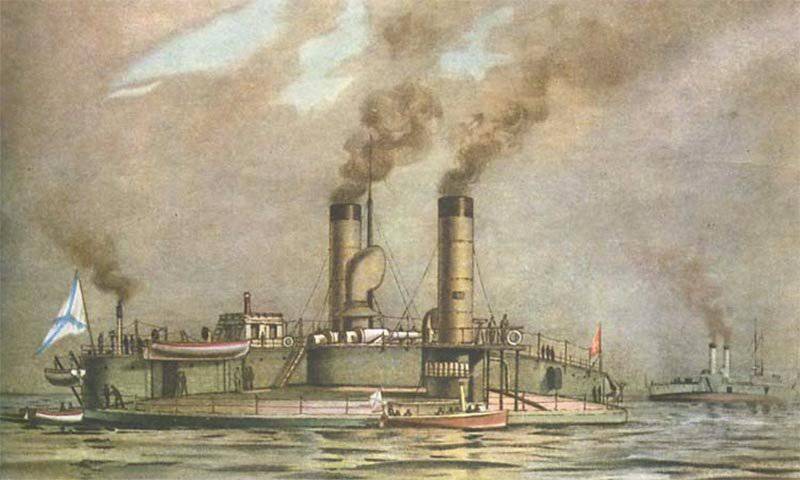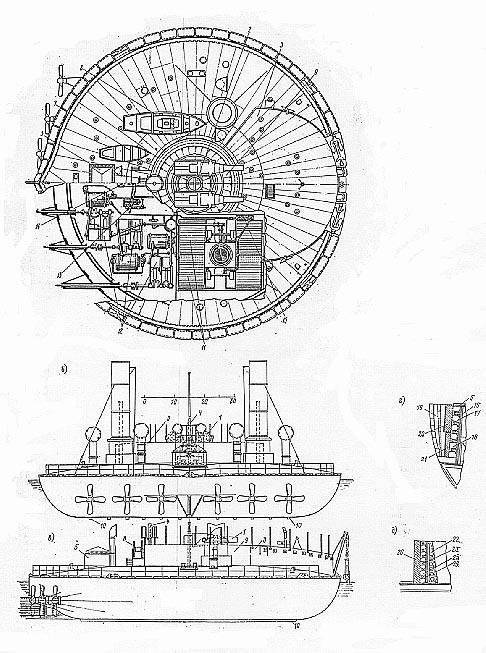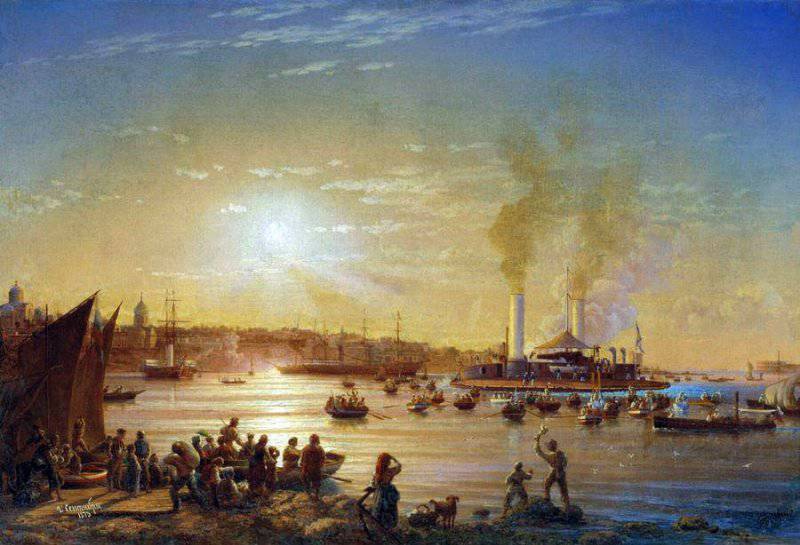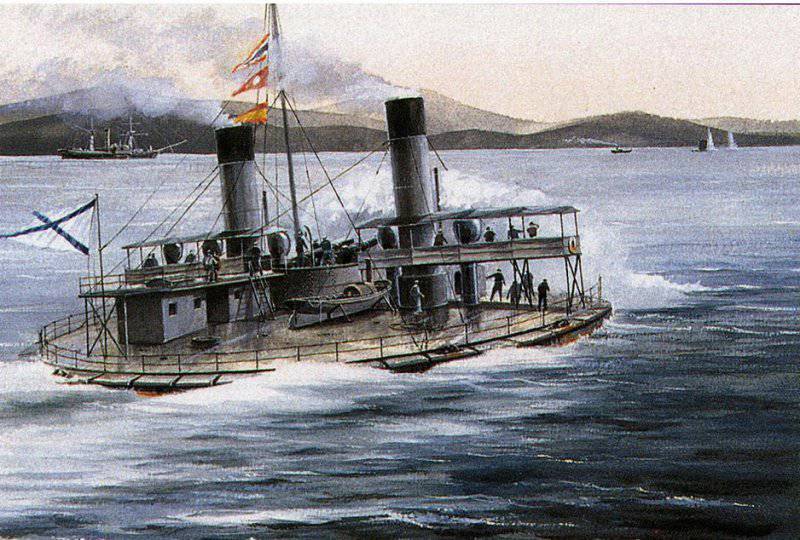Round court admiral Popov. Part of 4. Popovki in the Russian-Turkish war and new ideas
Inactivity on the Odessa raid of the Black Sea battleships in the early summer of 1877, and the appearance of Turkish military ships at various points on the Russian coast, caused “displeasure” from Admiral General. He made an attempt to intensify the actions of the backslides, even to send them for cruising at sea, however, he ran into opposition from Vice Admiral Arkas N.A. and Rear Admiral Chikhachev NM, Chief of Defense of Odessa. In his report, the latter wrote that "... the popovka will have to glorify the Russian flag on the high seas only at the cost of their own death ..." On the basis of the findings of a specially created commission and their own observations, the admirals noted the defensive role of these vessels, which had little speed , compared with the Turkish ships, lack of seaworthiness, a small radius of navigation and unreliable power plants. In addition, Chikhachev N.M. He reported that due to the weakness of the cannon machine tools of the second round vessel Popov, in practical shooting, "they did not dare to act with a full charge ... saving up the resistance force of the machine tools ... in case of emergency." Indeed, both round ships of Popov, despite the rather successful sea crossings, remained vessels of narrow specialization - floating forts. The turn of Novgorod usually did not exceed 5 nodes, and Vice Admiral Popov did not exceed 6 nodes. The speed, apart from the overgrown hulls, was affected by the lack of reliable ventilation of the engine and boiler rooms: after the Turkish monitor was killed on the Danube, allegedly from hanging fire, light hatches and central hatches of the barbet on both ships were covered with armor cavities with small holes and vents were removed. As a result, the temperature in the furnaces jumped up to 40 — 50 degrees, the team exhausted from the heat could not keep full speed for a long time, the stokers had fainting. Due to the lack of insulation of the living quarters and the ventilation, the sailors did not have a good rest during the long voyages in the summer, and in the cold they suffered from lack of steam heating. On each popovka the circulation time by the steering wheel was 40-45 minutes, so it was necessary to maneuver with the help of machines, reducing, respectively, the course. The course in fresh weather has decreased even more. For fuel, the autonomy of the packs was, at best, 5 days.
The leadership of the maritime department was forced to agree with the presented estimates of the actual condition of the backwaters and leave them for the defense of the water area of Odessa.
To protect the minefields and coastal fortresses from the raids of the Turkish fleet, the Black Sea coasters were forced to hastily adapt small ships and barges of the ROPiT as canoners and floating batteries, and to strengthen the defense of Ochakov and build armored rafts for the Kerch Strait. These facts speak about the ill-conceived program of building ships for the Black Sea Fleet, albeit a “defensive” one, but consisting only of assassinations. Even if they had built four popovki, gunboats for the coastal defense of the Danube and cruisers, instead of which cargo-passenger ships adapted, would still be necessary. And it was not the fault of the inventor Popov A.A. that the solution proposed by him for one of the problems of the reviving fleet was taken as the only right thing for everyone, but the funds available in the treasury were spent on building experimental ships. In the end, created to supplement the defense of the coastal fortresses, they, according to all available data, were completely satisfied. Admiral Popov, who achieved practically uncontrolled embodiment of his ideas into ships, is to blame for the fact that the proposed ships tried to use the reviving fleet as a strike force ... As a result, Russia, poor in financial means, amazed rich England so much that in 1876 by British engineers and the admirals seriously discussed the issue of the suitability of round ships to protect the metropolis.

Despite the fact that the Black Sea battleships recognized only a defensive function, the fleet leaders prepared in detail for the battles. In both vessels, light navigational logging, which hampered the shooting, was removed in the first half of 1877, at the same time, two 87-millimeter cannons were installed on the aft bridge of Novgorod. On the wings of the side bridges of the second popovka they decided to place a couple of quick-fire guns. In October, combat shots were fired at a distance of 700 meters into a shield, imitating the defeat of the reserved side of an enemy ship. Novgorod from eight shots achieved five direct hits, Vice Admiral Popov - from eleven eight. In the fall, the captain of the second rank, Bistrom KR, became the commander of the last battleship, and his place on Novgorod was occupied by captain of the second rank Balk A.O. Both commanded ships up to the 1884 year.
The winter of 1877 — 1878 was held in continuous repairs: the teams sifted through the machines, the Nikolaev and Odessa craftsmen laid the roofs of the deck’s superstructures, and sheathed the interior rooms with wood. Fan machines were installed on Novgorod again, and on the second popovka they decided to install the pictures taken from Peter the Great.
In Nikolaev, by this time they had finished assembling a new single-wall floating dock with a lifting force of 3600 tons. This original Standfield engineer facility, suitable for lifting not only ordinary ships, but also round ships, was built in England in the 1876 year. It took more than a year to deliver its parts and mechanisms to the Nikolaev Admiralty, as well as equipment and machines for the final assembly of the dock. The author of the project supervised the work, the most initiative assistant of Popov, Captain E. E. Gulyaev, supervised their progress in England and Russia. The total cost of construction, with improvements made by the same Gulyaev, amounted to about a million rubles.
19 February The 1878 of the year the San Stefano peace treaty was signed, however, due to strained international relations, the courts remained in full combat readiness. In the summer they are under the flag of N. M. Chikhachev. made a good practical sailing in Sulin on the Danube; at the junction, the speed was about 6 nodes. Despite the fears and rumors leaked to the newspapers, the popovans confidently maneuvered during a strong current on the river.
After the hull ships were cleared in the new dock, it was planned to transfer to Sevastopol and complete the campaign. It happened with Novgorod, but Vice Admiral Popov remained in the ranks until January 1879. Finally, new platforms and machines began to be mounted on it. By the beginning of 1878, all parts of them were transported to Odessa and prepared for installation on the Quarantine Harbor embankment. More than six months were spent on preparatory work. Popovka with new machines in November came to the test. The artillery system, according to the report of the commander, acted satisfactorily, "the machines smoothly rose and fell." Bistrom K.R. believed that with a quiet rolling stop the shooting is possible only in connection with the flooding of the tower. So, for example, with a headwind with 7 points "through the clouds, barbet ports, the front fans took quite a lot of water ... they pulled out the steering wheel and the ship did not obey the steering wheel, it was necessary to fix the steering wheel and edit the cars ..." (on the backs the steering gear was manual and in a usual situation on the move with a steering wheel two or three steering were controlled). In December, Vice Admiral Popov, despite the winter weather, sailed from Sevastopol to test the machines. This time the ship was attended by Admiral A.A. Popov, his assistants E.E. Gulyaev. and Rasskazov LA, as well as a representative of the firm Armstrong. The machines worked perfectly even with strong agitation, although they could not turn around, since the corresponding mechanism had not yet been established. On the transitions, the average speed was 6 nodes, the maximum - 7,5 on the lag. The swell run was reduced to 3,5 nodes, as the screws became bare, but the pitching remained smooth.
Vice Admiral Popov, with a fully assembled artillery system, in January 1879 re-entered the sea, where he successfully fired 33 from both guns. Dropping machines turned easily and smoothly, neither barbet nor platform had any damage. Between the shots, the average gap was 7 minutes, each gun was charging for about 14 minutes. The commander of the ship recognized hand-bathing as the main loss of time, and believed that during the mechanization of this process, it would take less time in 3 to load. The guns operated at distances 2-30 cable.
Battleship the entire first half of the year strenuously put in order and prepared for the general tests. The freeboard, superstructure walls, upper deck and pipes, instead of protective paint, were coated with white paint. The machines were repaired again, since the Lesovskiy S.S. instructed to test them "until the mechanisms develop the indicator force specified in the contract ..."
Popovka was shown in summer and autumn in all its glory to Admiral General and Lesovsky S. Surprisingly, the manager was "nautical qualities extremely pleased ...: the waves do not take (!?) And at the same time, the pitches are unusually small ...". Swing pitching, applied to the report Lesovsky S.S. the grand prince of the table, with different wind directions and waves, whose speed reached 7 points during the tests, on the move in 5,5 — 6,5 nodes did not exceed 6 — 7,5 degrees, and their number was thirteen. The swing span at a speed of up to 7,5 knots and otherwise wind was the same magnitude, and at anchor and at low pitching speeds did not exceed 4,5 degrees.
The stability of the round vessel Popov on the waves, which was discovered during the first exits of Novgorod, as well as the relative seaworthiness again gave the author hope for using his ships for operations at sea. In fact, on both ships he began to work out the idea of creating a round armadillo capable of operating on the high seas. This explains the reconstruction on the deck of Novgorod and the increased volume of superstructures at Vice Admiral Popov, the increase in power of the power plant of this vessel, the depth of propellers and numerous, sometimes quite risky, hikes in the open sea.
To increase the radius of navigation seriously worked out the possibility of installing auxiliary sailing armament! For this purpose, in 1874 — 1875, under the supervision of Lieutenant Makarov S.O. 3 was built round wooden sailboats. The first two of them were saberboats with retractable keels and armed with tenders. Their diameter was 4,6 meters, they were built in Tsarskoe Selo and Sevastopol. The third, which was built on the New Admiralty, had a similar design, but its diameter was 6 meters. She was repeatedly tested on Lake Tsarskoye Selo. "Popovochka" confidently sailed, perfectly managed and tacked in the wind ...

In order to determine whether the round vessels of Popov could achieve the speed of 12 — 14 nodes, ship models, for the first time in Russian shipbuilding, were tested in the 1875 — 1876 years in the William Froude test basin, the only testing ground in the world for model towing tests. Scientific findings confirmed the Black Sea full-scale tests: Frud, firstly, proved that at speeds above 9 nodes, popovka buries into the water, and secondly, to achieve a speed on the order of 14 nodes, it will be necessary to increase the power of the ship’s power plant five times! An English researcher based on the results of his experiments built a “diagram of armor and guns that ships can carry at speeds of 12 — 14 knots”, demonstrating the obvious — the need to move away from the circle shape: the test models (boards) were, in the first approximation, augmented with sharp pointed accessories. At this, ellipsoid form, it was possible to assume the achievement of the required speeds, while reducing the precipitation. In 1877, inspired Popov A.A. drew up a project elliptical battleship. Judging by the instructions of the Admiral General about the requirements for the future battleship, the next popovka should carry 610-millimeter armor and four 80-ton 406-millimeter guns; its velocity, with a draft in 6,1 — 6,7 meters, was determined in 12 nodes. A year later, the case provided the inventor with the opportunity to put his new idea into practice.
Tactical and technical elements of "Novgorod" on 1884 year:
Ship diameter - 30,78 m;
Bottom diameter - 23,16 m;
Draft at full displacement:
nose - 4,11 m;
stern - 4,09 m;
Freeboard midships - 0,46 m;
Diameter barbet:
external - 9,14 m;
internal - 8,23 m;
Barbette height - 2,90 m;
Full displacement - 2491 t;
Number of steam engines - 4 (when building 6 steam engines)
Total power - 2000 l. with. (total power when building 3360 HP);
The number of screws is 4 (originally 6 screws);
Number of boilers - 8;
Travel speed:
the largest - 6 nodes (the highest speed in 1873 - 1876's 7 nodes);
economic - 5 nodes;
Coal reserve in the pits - 200 t;
Cruising range at full speed - 480 miles;
Armament:
the number of guns - 2;
caliber - 280 mm;
Booking:
board - 178-229 mm;
board with lining - 229- 280 mm;
barbet - 229 mm;
barbet with padding - 280 mm;
deck - 70 mm;
Crew:
officers - 15 people;
sailors - 136 people;
The cost of the ship is 2,83 million rubles.
The tactical and technical elements of "Vice Admiral Popov" on 1884 year:
Ship diameter - 36,57 m (actual measurements according to the builders: width - 35,86 m, length - 38,66 m);
Bottom diameter - 29,26 m;
Draft at full displacement:
nose - 4,11 m;
stern - 4,49 m (with medium screws - 5,79 m);
Freeboard midships - 0,46 m;
Diameter barbet:
external - 10,36 m;
internal - 8,84 m;
Barbette height - 3,35 m;
Full displacement - 3600 t;
Number of steam engines - 6 (when building 8 steam engines);
Total power - 3066 l. with. (when built, the total power 4480 HP.);
The number of screws - 4 (when building 6 screws);
Number of boilers - 12;
Travel speed:
the largest is the 8,5 node;
economic - 6,5 node;
Coal reserve in the pits - 250 t;
Cruising range at full speed - 540 miles;
Armament:
the number of guns - 2;
caliber - 305 mm;
Booking:
board - 178-406 mm;
board with lining - 229-457 mm;
barbet - 406 mm;
barbet with padding - 457 mm;
deck - 70 mm;
Crew:
officers - 15 people;
sailors - 136 people;
The cost of the ship is 3,26 million rubles.
- Round court admiral Popov. Part of 1. The history of the creation of round armadillos for the Black Sea
Round court admiral Popov. Part of 2. Bookmark "Novgorod"
Round court admiral Popov. Part of 3. "Vice Admiral Popov"
Round court admiral Popov. Part of 4. Popovki in the Russian-Turkish war and new ideas
Round court admiral Popov. Part of 5. Imperial yacht "Livadia"
Round court admiral Popov. Part of 6. The fate of pardons


Information